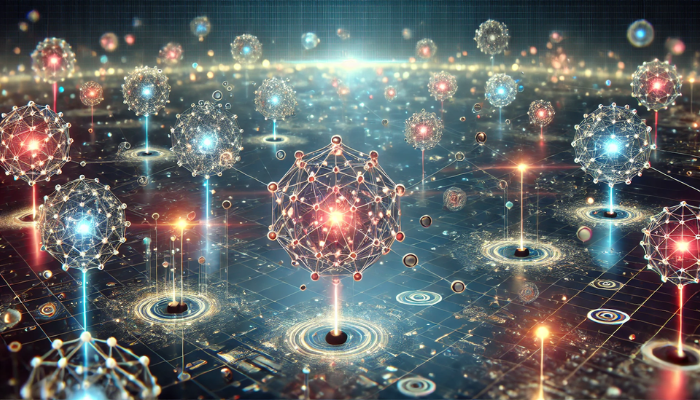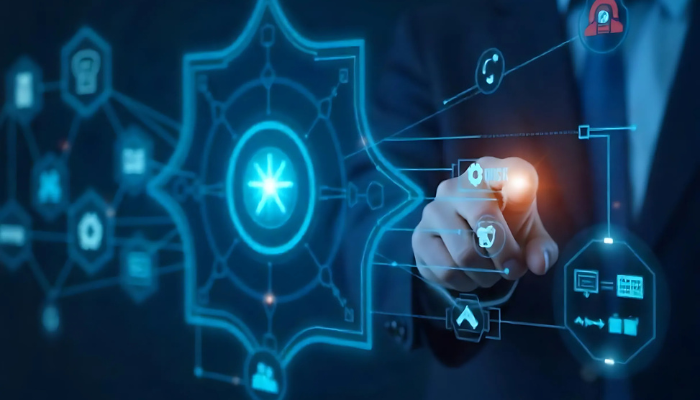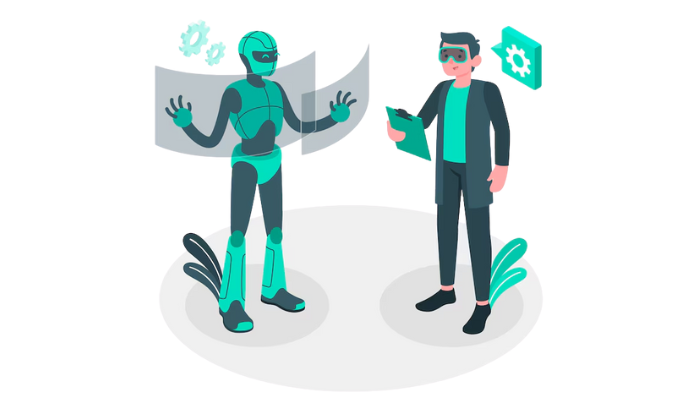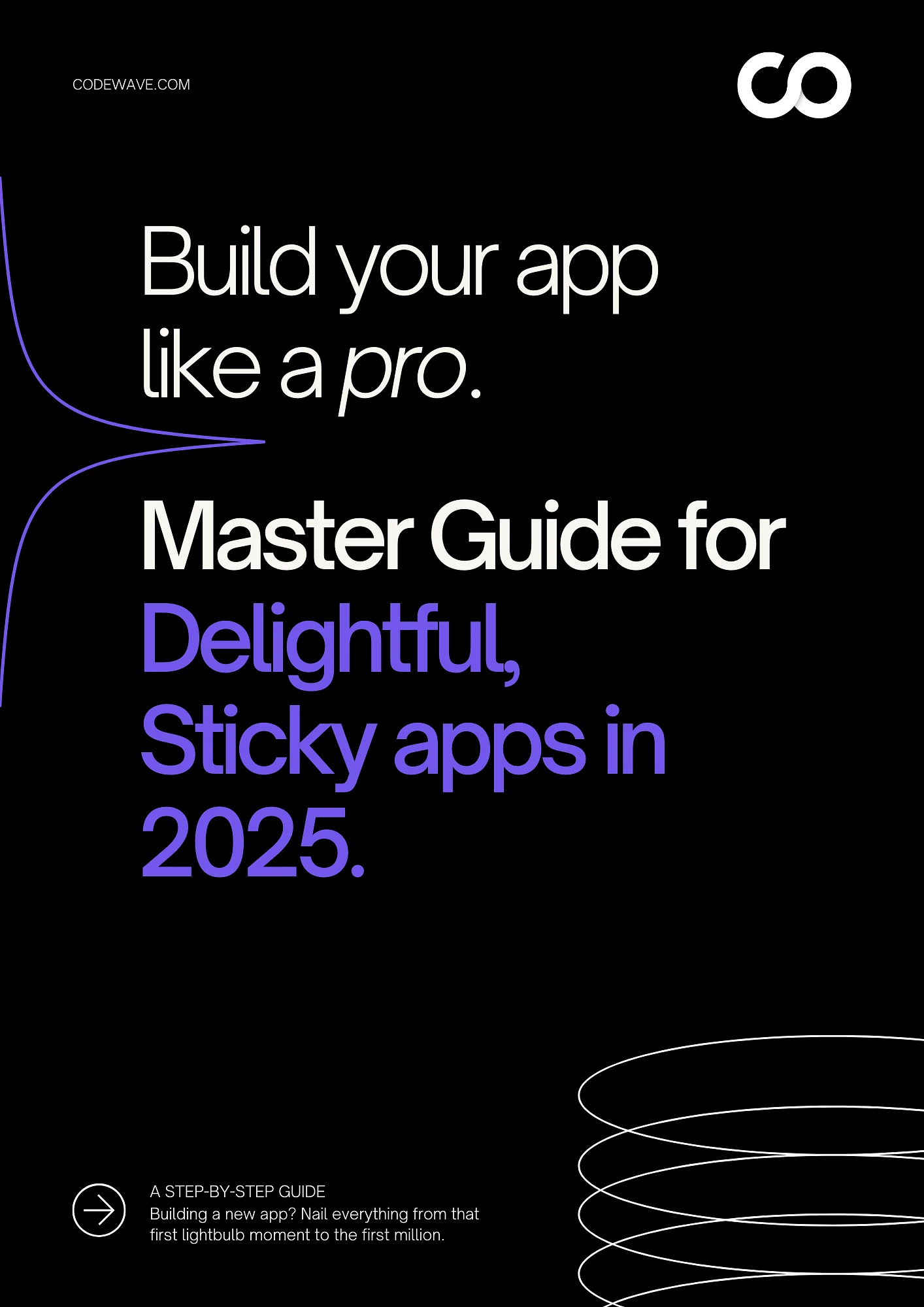Agentic AI has moved from theory to deployment. Businesses now use autonomous systems that can reason, make decisions, and adapt without constant human oversight.
But when multiple such systems operate together and coordinate in real time, a new model emerges: swarm agentic AI.
Swarm agentic AI involves a distributed network of goal-driven agents that collaborate without a central controller. Each agent operates semi-independently, but together, they respond to change, divide tasks, and optimize outcomes through emergent behavior.
According to IDC, 45 percent of manufacturing and logistics firms will rely on distributed intelligent agents for real-time decision-making by 2027.
This move from standalone agents to dynamic agent collectives is not just a technical shift. It changes how businesses structure automation, manage workflows, and deliver services at scale.
If you’re building AI systems that need to reason, adapt, and scale across workflows or environments, this is the architectural shift to watch. Let’s start with the basics.
What Is Swarm Agentic AI?
Swarm agentic AI refers to a distributed system composed of multiple autonomous agents, each capable of sensing, reasoning, and acting independently, yet working together toward shared objectives. These agents operate without a central controller, coordinating their actions through decentralized communication and local decision-making.
In simpler terms, swarm agentic AI behaves like a digital colony. Each agent is intelligent on its own but becomes significantly more powerful when interacting with others in a shared environment.
How It Differs from Other AI Models
To understand where swarm agentic AI fits in the landscape, it’s useful to compare it to more common AI architectures:
Traditional AI Agents
Traditional agents are typically isolated systems designed to complete a narrow task, such as extracting data from forms or responding to customer queries. They do not communicate with other agents or adapt based on the behavior of nearby systems. Their scope is limited, and their decision-making is often rule-based or single-model driven.
Centralized Agentic AI
Centralized agentic AI uses a single large model, often an LLM, that acts as the brain for multiple downstream tasks. It may coordinate across APIs and tools, but all decisions flow from one central logic engine. While powerful, this architecture introduces bottlenecks and creates single points of failure. It also struggles in environments that require high-speed parallel processing or decentralized decision execution.
Swarm agentic AI addresses these constraints by distributing both intelligence and control across agents that can operate and adapt in parallel.
Where Swarm Agentic AI Fits Best
Swarm agentic AI is especially effective in environments that are dynamic, decentralized, and require real-time decision-making. Here are a few real-world scenarios where this architecture shines:
- Autonomous drone operations: In large-scale search and rescue missions or aerial monitoring, a swarm of drones can divide coverage areas among themselves, reroute in response to obstacles, and adapt to weather or signal changes, all without needing a central command system.
- Smart energy distribution: In energy grids, individual nodes such as substations or smart meters can act as agents that adjust power distribution in real time based on local demand. This reduces the risk of overloads and improves overall grid efficiency without relying on a central control center.
- Customer support automation: Instead of a single AI agent managing all tickets, a swarm of specialized agents can categorize incoming requests, route them to the right department, and even resolve common queries autonomously. As volume fluctuates, these agents can reprioritize tasks dynamically and escalate issues when needed.
- Industrial robotics in manufacturing: On factory floors, robots often perform interdependent tasks. With swarm intelligence, each robot can adjust its behavior based on what nearby robots are doing. For example, if one robot encounters a delay, others can automatically rebalance workloads or take over complementary tasks, keeping production smooth and adaptive.
These examples illustrate how swarm agentic AI reduces bottlenecks, improves response times, and builds resilience into systems that must operate under complex, shifting conditions without needing a single point of control.
Key Traits of Swarm Agentic AI
There are four defining characteristics that make swarm agentic systems distinct:
- Autonomy: Each agent can operate independently with its own goals and reasoning capability.
- Coordination: Agents exchange signals or share observations to avoid conflict, reduce duplication, or form collaborative strategies.
- Emergent intelligence: Higher-order behavior arises from local interactions. The system learns and adapts without explicit programming of group behavior.
- Decentralized control: No single point of failure or orchestration. Control is distributed, which enhances flexibility and resilience.
Next, we’ll break down the core technical components that make swarm agentic AI systems possible in the real world.
Core Principles Driving Swarm Agentic AI
Swarm agentic AI is not just a technical setup. It is grounded in a specific set of principles that guide how intelligence is distributed, how coordination emerges, and how systems remain robust under pressure. These principles differentiate swarm-based models from centralized or isolated-agent approaches.
1. Distributed Intelligence
In swarm systems, no single agent has complete visibility or authority. Each agent has limited knowledge, yet the collective system performs complex reasoning through collaboration. Intelligence is not located in one model or layer, it emerges from the network as a whole.
This distribution allows systems to operate without bottlenecks. It also makes them more adaptable, as local agents can continue functioning even if others fail or go offline.
2. Emergent Behavior
Swarm systems often display behaviors that were not explicitly programmed. These patterns arise when multiple agents interact according to simple local rules. Over time, the system self-organizes, adapts to external inputs, and even optimizes toward outcomes not coded in advance.
In practice, this means that system designers focus less on direct control and more on designing the right agent behaviors and interaction rules to trigger useful system-wide patterns.
3. Stigmergy
Stigmergy is a form of indirect communication where agents leave signals in their environment for others to interpret. In digital systems, this might look like writing to a shared memory store, updating a task queue, or flagging states in a vector database.
This mechanism allows agents to coordinate without needing persistent connections or synchronized clocks. It also enables asynchronous planning, where agents influence each other simply by observing state changes.
4. Resilience and Scalability
Swarm agentic systems are naturally fault-tolerant. Since agents operate independently, the failure of one or more units does not bring down the entire system. Redundant capabilities and decentralized control mean that the system continues to function, often without performance degradation.
These systems also scale horizontally. Adding more agents increases capability, coverage, or throughput without re-architecting the core logic.
Next, we’ll compare how this architecture differs from centralized models and where it offers clear operational advantages.
Architecture and System Design
To bring swarm agentic AI into production, you need more than conceptual alignment. You need a system architecture that supports decentralized reasoning, real-time collaboration, and adaptive task execution across many agents. This section outlines the key components and patterns that make that possible.
Core Components of Swarm Architectures
- Independent Agent Nodes
Each agent is an autonomous software entity capable of making its own decisions. These nodes operate on local inputs, run their own policies or LLM prompts, and can execute actions without waiting on a central coordinator. - Communication Protocols
Agents rely on lightweight, event-driven communication to coordinate. This is typically handled through message queues (e.g., RabbitMQ, Kafka), broadcast channels, or publish-subscribe systems like Redis Streams. Communication must be fast, fault-tolerant, and decoupled. - Shared or Distributed Memory
Swarm agents may read from or write to a shared memory layer. This could be a vector database for semantic recall, a key-value store for task status, or a graph database representing shared world state. The goal is to support asynchronous coordination and cross-agent learning without tight coupling. - Conflict Resolution and Decentralized Planning
Task overlap is inevitable when agents act in parallel. Effective swarm systems include rules or algorithms for resolving conflicts, negotiating priorities, and reassigning tasks dynamically. This can be driven by token-passing, probabilistic selection, or bidding-based models depending on the use case.
For a deeper look at the architectural foundations of agentic AI systems and how frameworks shape modular autonomy, explore our in-depth guide on Agentic AI frameworks and architecture.
Architectural Patterns That Support Swarm Behavior
Swarm systems can be deployed using different coordination topologies, depending on how much structure or flexibility is required.
- Peer-to-Peer (P2P)
Agents connect directly and form an ad hoc network. This is suitable for use cases where agents must operate without any fixed infrastructure, such as drone swarms or edge IoT devices. - Hub-and-Spoke with Agentic Planning Hub
A hybrid model where agents remain autonomous but occasionally sync with a planning hub that helps reprioritize tasks or resolve system-wide constraints. Useful for enterprise systems needing guardrails. - Leader Election Systems
In some swarms, a leader agent is elected temporarily to facilitate coordination for specific scenarios. This is common in distributed consensus models where tasks require temporary orchestration.
Tools for Multi-Agent Swarm Architectures
Several tools have emerged that support swarm-based coordination in agentic systems:
- LangGraph: For stateful multi-agent workflows with branching logic and memory across steps.
- CrewAI: Designed for coordinating task-specific agents within a shared environment.
- AutoGen: Enables inter-agent messaging and multi-turn conversations among LLM-powered agents.
- Vector Databases (e.g., Weaviate, Pinecone): Used to share long-term context or retrieve goal-relevant memory.
- Redis Pub/Sub and Kafka: Popular messaging backbones for real-time data exchange between agents at scale.
Curious which frameworks suit your use case best? Our blog on the top agentic AI tools and frameworks breaks down capabilities, limitations, and real-world fit.
In the next section, we’ll look at how these systems perform compared to centralized agentic models.
OpenAI’s Swarm Framework: What We Know So Far
While OpenAI has not released a formal “Swarm” product as of this writing, its research and community experiments signal a growing interest in collaborative, decentralized agent systems. The company’s recent open-source tools and publications hint at foundational ideas shaping a future swarm-capable framework.
Multi-Agent Collaboration in GPT Architectures
OpenAI’s tooling increasingly supports multi-agent interaction models, where several GPT-based agents run concurrently with distinct roles. These agents are designed to:
- Hold specialized responsibilities (e.g., one agent generates content, another fact-checks, another critiques tone)
- Share context through memory systems or structured prompts
- Negotiate or revise plans over multiple cycles to refine outputs
This framework prioritizes collaboration without central control, aligning well with swarm agentic AI principles.
Emphasis on Specialization and Delegation
Rather than deploying a single, general-purpose agent to complete a task end-to-end, OpenAI’s approach encourages modular agent roles. Each agent becomes an expert in a narrow domain and interacts with others to reach a shared objective.
Examples include:
- Writing workflows where one GPT drafts, a second critiques, and a third edits the result for clarity
- Research agents that pull from web sources, evaluate reliability, and summarize findings for downstream decision-making
- Negotiation-style systems, where agents debate trade-offs in planning scenarios before finalizing an output
Long-Running Goals and Iterative Reasoning
OpenAI’s research prototypes also demonstrate support for long-running tasks, where agents maintain continuity across multiple stages of reasoning. Instead of completing a task in one prompt cycle, agents can:
- Track progress toward a high-level goal
- Re-evaluate intermediate results
- Trigger sub-goals or replan if the context shifts
This kind of sustained reasoning is foundational for real-world swarm deployments, where agents must adapt strategies over time rather than follow static task flows.
A Glimpse into Swarm-Capable Systems
While much of this work is still in experimental or beta form, OpenAI’s direction suggests a move toward more composable, self-organizing agent ecosystems. These systems don’t just respond to instructions; they reason together, learn from each other’s outputs, and adapt based on what the group produces.
The practical implication for developers and product teams is clear: multi-agent coordination is no longer theoretical. Tools like AutoGen, along with evolving orchestration patterns in the OpenAI API, are paving the way for systems that reflect swarm agentic AI characteristics, without requiring deep infrastructure work from scratch.
In the next section, we’ll look at specific industries where swarm agentic AI is already driving value and solving coordination challenges that traditional automation struggles with.
Use Cases and Industry Applications
Swarm agentic AI is moving beyond theoretical frameworks and research papers. It is already making its way into high-stakes environments where real-time collaboration, distributed processing, and continuous adaptation are essential. Below are examples of how this architecture is being applied across industries.
a. Autonomous Research and Strategy
In domains like market intelligence, competitive analysis, and scientific R&D, research workflows can now be broken into coordinated agent tasks. Each agent focuses on a specific part of the process that is reading literature, extracting key points, evaluating bias, and testing logic.
For instance, in a strategy-planning scenario:
- One agent gathers and summarizes recent regulatory updates
- Another tests implications against internal product plans
- A third critiques assumptions or flags inconsistencies
- The system then refines the recommended path forward based on collective reasoning
This swarm-based approach allows teams to run deep analysis without linear bottlenecks, delivering more refined insights in less time.
b. Cybersecurity Defense Networks
In cybersecurity, the threat landscape evolves too quickly for human analysts or monolithic systems to keep up. Swarm agentic AI enables the deployment of autonomous agents across network layers that:
- Monitor activity in parallel
- Flag anomalies at edge points
- Share signals about new threats with peer agents
- Coordinate containment or mitigation plans in real time
Unlike traditional SIEM tools that rely on central correlation, these systems adapt on the edge and escalate only when needed. This reduces breach windows and improves response precision.
c. Healthcare Coordination
Modern healthcare involves multiple systems: EHR platforms, diagnostics tools, alert engines, scheduling systems and all operating with their own data silos. Swarm agentic AI enables autonomous agents to bridge these gaps by:
- Proactively flagging appointment delays or equipment clashes
- Suggesting schedule adjustments to reduce patient wait times
- Cross-checking treatment recommendations against evolving medical guidelines
- Notifying staff or adjusting task loads in real time when priorities change
Instead of requiring manual coordination, these agents collaboratively manage continuity of care across systems and teams.
d. Smart Manufacturing and Robotics
Manufacturing floors are increasingly populated by sensor-rich machines and robotic units. Swarm agentic AI offers a way to decentralize control and drive real-time optimization:
- Each robot or workstation functions as an agent with local objectives
- Agents adjust speed, behavior, or tool choice based on nearby activity
- They can self-organize around bottlenecks, reroute flows, and balance throughput
This design improves fault tolerance and lets the system maintain uptime even if some agents go offline or malfunction. It also simplifies scaling, new machines can be added without reprogramming the entire system.
e. Financial Intelligence
In asset management and trading, market responsiveness is critical. Swarm agentic AI allows firms to deploy agent teams that specialize in:
- Tracking individual sectors or asset classes
- Monitoring policy shifts, macroeconomic signals, or sentiment data
- Sharing observations with peer agents to re-align short-term positions
- Generating and testing portfolio strategies based on composite insights
This architecture increases speed-to-decision and lets analysts focus on strategic oversight while agents handle dynamic execution in volatile markets.
Each of these use cases reflects one core benefit of swarm agentic AI: the ability to respond faster and more intelligently than any single model or centralized system could. Up next, we’ll explore the challenges in adopting this architecture and the strategic shifts teams must prepare for.
Implementation Challenges and Ethical Considerations
Swarm agentic AI promises speed, resilience, and coordination across distributed systems. But with these gains come non-trivial challenges in deployment, oversight, and ethical governance. As enterprises move from centralized orchestration to collective intelligence, several key issues demand attention.
1. Control and Oversight
In a decentralized swarm, no single node dictates decisions. While this eliminates central bottlenecks, it also raises the question: who maintains accountability when actions emerge from group dynamics?
Organizations need mechanisms to:
- Define governance boundaries for agent behavior
- Set thresholds for human intervention in critical workflows
- Establish guardrails for agents interacting with users or external systems
Without structured oversight, even well-meaning swarms may drift from intended objectives, especially in environments with fast-changing priorities.
2. Trust and Explainability
Emergent behavior is one of the defining strengths of swarm architectures—but it also makes decision paths difficult to trace.
Unlike rule-based agents or single-model systems, swarms often evolve solutions through interaction rather than explicit instructions. This creates challenges in:
- Auditing decisions for compliance or security reviews
- Understanding why the system acted in a particular way
- Debugging unexpected behavior without access to a single decision log
Building transparency into these systems requires robust event tracking, contextual memory, and visualization tools that make collective decision-making legible to human reviewers.
3. Security Vulnerabilities
Every independent agent is a potential attack surface. If a single agent is compromised or misconfigured, it could:
- Disrupt local coordination
- Mislead other agents through false signaling
- Cascade bad decisions across the swarm
Security architecture must be designed to validate agent communication, isolate suspicious nodes, and rapidly quarantine or replace malfunctioning units without halting the entire system.
Zero-trust principles, cryptographic agent identities, and behavior baselining are essential here.
4. Resource Consumption at Scale
While individual agents can be lightweight, deploying a large number of them increases compute, memory, and communication overhead.
Teams must weigh:
- The trade-off between agent granularity and infrastructure cost
- Latency introduced by distributed messaging
- The need for scalable memory layers and fault-tolerant messaging infrastructure
Tooling such as vector databases, Redis clusters, and low-latency orchestration frameworks can mitigate some of this, but implementation demands careful planning.
5. Ethical Boundaries and Human Agency
Swarm agents may eventually make decisions that supersede or conflict with human instructions, especially when optimizing for system-wide goals.
This raises important ethical concerns:
- Should agents be allowed to override user preferences to protect system integrity?
- How should conflicts between individual benefit and collective efficiency be resolved?
- What happens when agents negotiate or reassign responsibility without human input?
Ethical design here includes not just rulesets, but also escalation protocols, transparency settings, and user consent mechanisms baked into system behavior.
Future of Swarm Agentic AI
As infrastructure, orchestration frameworks, and enterprise readiness improve, this model is becoming central to how businesses design adaptive, scalable automation.
Market and Adoption Signals
Adoption is accelerating. Gartner projects that by 2028, 33 percent of enterprise software will include agentic AI features, with swarm-based coordination playing a key role in environments that demand dynamic, real-time decision-making.
The global market for AI agents is forecasted to reach 47.1 billion USD by 2030, with a compound annual growth rate of 44.8 percent. This includes use cases in manufacturing, healthcare, logistics, cybersecurity, and other sectors where centralized automation struggles to keep pace with operational complexity.
What’s Emerging on the Horizon
Several technology and product trends are beginning to shape the future of swarm agentic systems:
- Swarm-enabled copilots: These will move beyond single-user productivity assistants to become multi-agent systems that collaborate across teams and workflows.
- Containerized and microservice-based agents: Instead of running as static processes, agents will operate as independently deployable services. This enables rapid updates, fault isolation, and modular scaling.
- Swarm intelligence at the edge: Expect to see more agent clusters running on edge devices, drones, or IoT nodes. Decisions will increasingly happen where the data is generated, improving speed and reducing reliance on central cloud systems.
- Self-configuring agent networks: As tools evolve, agents will begin to redefine their own goals, roles, and tool chains based on system feedback and real-world outcomes.
Open Questions That Will Shape Adoption
As momentum builds, key questions remain that will influence how swarm architectures are designed and governed:
- Can distributed intelligence outperform large, centralized models in production? Swarm systems offer advantages in speed and resilience, but their comparative accuracy and efficiency still need broader validation.
- How do we ensure oversight and quality in emergent decision-making? Group-level behavior is difficult to script. New approaches to safety, fallback planning, and anomaly detection are needed.
- What does governance look like in a decentralized system? With no central agent, roles like conflict resolution, auditing, and ethical enforcement need to be built into the swarm itself or supported externally.
Swarm agentic AI is not simply the next step in automation. It changes how teams think about intelligence, coordination, and scale. In the final section, we’ll show how Codewave helps product and engineering leaders implement these architectures in the real world.
How Codewave Helps You Build Agentic Swarm Systems
Swarm agentic AI systems require more than just autonomous agents. You need a distributed architecture, real-time coordination, and mechanisms to keep decisions aligned with business goals. At Codewave, we bring these elements together to help you move from concept to deployment with confidence.
How We Build Swarm-Based Intelligence
1. Modular AI Agent Design
We build agents that are goal-driven, stateful, and capable of reasoning based on context. Using frameworks like LangGraph, AutoGen, and ReAct, we define agent roles, memory structures, and planning loops. Each agent is built to operate independently, but communicate as part of a larger system.
- Local policies for fast decisions
- Vector-based memory for past context
- Multi-step planning logic per agent
If you’re just getting started with AI agent development, check out our step-by-step beginner’s guide to understand how to structure agents, define goals, and design interaction flows.
2. Distributed System Architecture
We implement infrastructure that supports real-time, decentralized execution. This includes:
- Pub/Sub communication using Redis or Kafka
- Vector databases (like Weaviate or Pinecone) for shared context
- Microservice-based deployment so each agent can run in its own container
- API layers for integrating external data sources, tools, or user feedback
3. Swarm Coordination Logic
We implement mechanisms that allow agents to coordinate tasks without centralized control. This includes:
- Leader election for dynamic role assignment
- Bidding systems for task distribution
- Shared task boards and state updates using lightweight messaging systems
4. Governance and Oversight
To ensure alignment with business processes, we integrate control checkpoints and human-in-the-loop flows:
- Approval workflows for high-impact actions
- Audit trails to log agent decisions and escalations
- Fallback rules when tasks fail or ambiguity arises
Where This Architecture Delivers Value
- Retail: Agents monitor real-time inventory, pricing trends, and competitor updates, then coordinate to adjust pricing across categories
- Fintech: Autonomous swarms track portfolio performance, react to market signals, and rebalance holdings based on predefined thresholds
- Healthcare: Agents synchronize treatment schedules, suggest care adjustments, and trigger alerts across systems without delay
- Logistics: Fleets of routing agents reroute deliveries, optimize for time and fuel, and collaborate to avoid congestion or overloads
Why It Works
We build every system to be:
- Modular: Start with a few agents and scale horizontally
- Observable: Every decision and signal is traceable
- Secure: Access is controlled by APIs, roles, and guardrails
Explore our AI services and portfolio to see what we’ve delivered across industries.
Want to see swarm agentic AI in action? Book a demo and talk to our solution architects.
Codewave is a UX first design thinking & digital transformation services company, designing & engineering innovative mobile apps, cloud, & edge solutions.







